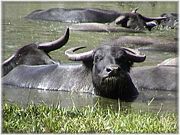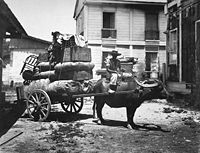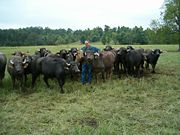Domestic buffalo
2008/9 Schools Wikipedia Selection. Related subjects: Mammals
| Domestic Asian Water buffalo | ||||||||||||||||||
|---|---|---|---|---|---|---|---|---|---|---|---|---|---|---|---|---|---|---|
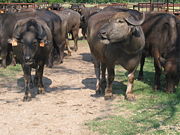 Domestic Asian Water buffaloes at a ranch in Arkansas, USA
|
||||||||||||||||||
| Scientific classification | ||||||||||||||||||
|
||||||||||||||||||
| Binomial name | ||||||||||||||||||
| Bubalus bubalis (Linnaeus, 1758) |
The domestic buffalo or domestic Asian water buffalo (Bubalus bubalis) is abundant in Asia, and widely used in South America, southern Europe and elsewhere. It is a large ungulate and a member of the bovine subfamily. There are established feral populations in northern Australia, and wild populations in much of Southeast Asia. All its domestic varieties and breeds descend from one common ancestor, the wild Asian water buffalo, which is now an endangered species.
Buffalo, apart from their use as draft and dairy animals, are also used to pull bullock carts in the developing world. Their dung is used as a fertilizer and as a fuel when dried. In Chonburi, Thailand, and in South Malabar Region in Kerala, India, there are annual water buffalo races. A few have also found use as pack animals carrying loads even for special forces.
American bison are often called buffalo; however, this is technically incorrect as they are not true buffalo. The bison group comprises the American bison and the European bison or wisent. They are a related group of wild bovines, more closely related to cattle, gaur, banteng, and yaks. The buffalo genus includes water buffalo, tamarau and anoas in Asia, but not the African buffalo (or Cape buffalo) in Africa.
The slightly smaller African buffalo is not closely related to the water buffalo, and its ancestry remains unclear. Owing to the African buffalo’s unpredictable nature, which makes it highly dangerous to humans, it has not been domesticated, unlike its Asian counterpart. The domestic Asian water buffalo is the product of thousands of years of selective breeding carried out by ancient civilizations, particularly in the Indian subcontinent.
Endangered wild Asian water buffalo
True wild Asian water buffalo (or wild Asiatic water buffalo) are thought to survive in India, Nepal, Bhutan and Thailand.
The IUCN Red List of threatened species classifies wild Asian water buffalo (Bubalis arnee) as an Endangered species. The total number of wild Asian water buffalo left is thought to be less than 4,000, which suggests that the number of mature individuals will be less than 2,500, and an estimated continuing decline of at least 20% within 14 years (ca. 2 generations) and at least 50% within 21 years seems likely given the severity of the threats, especially hybridization with the abundant domestic Asian water buffalo leading to genetic pollution.
Anatomy and morphology
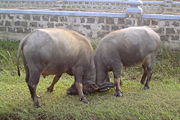
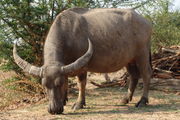
Adult water buffalo range in size from 300 kg to 600 kg for the domestic bred. In the wild, Wild Asian Water Buffalo can weigh up to 800 kg for females, and males, 1200 kg. They can stand as tall as 1.8m at the shoulder, and stretch up to 2.9m in body length. However, the wild buffalo subspecies found in the Assam state of Northern India, where they inhabit monsoon forests along the foothills of the Himalaya, are notably larger. Here, the average weight of a wild adult buffalo is 900 kg, with the male considerably larger than the female. The average height at the shoulder for a male is about 1.7m, and may reach even 2 metres. These wild buffaloes, which are of the purest breed in India, are now mostly found in the forests of Kaziranga and Manas national parks, both of which are UNESCO world heritage sites. They have also been known to spread into the northwestern region of the neighboring country, Myanmar.
With the establishment of the 20,000 km2. Hukaung Valley tiger reserve in 2004 in Myanmar, the largest ever protected wildlife reserve, now these huge wild buffaloes may have the hope of long-term survival. They are classified as critically endangered, suffering mainly from interbreeding with the domestic buffaloes (known as genetic pollution). Buffaloes are believed to have originated in South Asia. Today, outside India, the true wild water buffaloes can only be found in Thailand in extremely low number of about 50 individuals, and in the Annamites range (also called Truong Son range) forests running along the border of Vietnam - Laos -Cambodia. Populations found elsewhere in Asia are feral breeds, not true wild water buffalo.
Taxonomic history
The classification of the water buffalo is uncertain. Some authorities list a single species, Bubalus bubalis with three subspecies, the river buffalo (B. bubalis bubalis) of South Asia, the carabao or swamp buffalo (B. bubalis carabanesis) of the Philippines and Southeast Asia, and the arni, or wild Asian water buffalo (B. bubalis arnee). Others regard these as closely-related but separate species.
The swamp buffalo is primarily found in the eastern half of Asia and has 48 chromosomes. The river buffalo is mostly found in the western half of Asia, and has 50 chromosomes. The two types do not readily interbreed, but fertile offspring can occur. Buffalo-cattle hybrids have been reported in the former U.S.S.R. and in China, but these reports are considered unlikely, as cattle have 60 chromosomes (30 pairs).
Distribution
Asia

Asia is the native home of the water buffalo, with 95% of the world population of water buffalo, with about half of the total in India. Many Asian countries depend on the water buffalo as its primary bovine species. It is valuable for its meat and milk as well as the labour it performs. As of 1992 the Asian population was estimated at 141 million. The fat content of buffalo milk is the highest amongst farm animals and the butterfat is a major source of ghee in some Asian countries. Its success in Asia is evident by its extensive range. Both variants occur in Asia. River buffalo are found in elevations of 2,800 m in Nepal, and swamp buffalo are found throughout the lowland tropics. Part of their success is due to their ability to thrive on poor foodstuffs and yet be valuable economically. Moreover they are much better suited to plough the muddy paddy fields as they are better adapted than common cattle (Bos taurus) to move in swamps.
Wild water buffalo are found in India, Pakistan, Bangladesh, Nepal, Bhutan and Thailand, but very few pockets still exist. Like its other family members the tamaraw and the anoa, buffalo are generally found in swamplands and grass jungles and move in herds. The Indian buffalo has the largest horns of any living animal - the average spread is about 1 m (3 ft 3 in), but one bull shot in 1955 had horns measuring 4.24 m (13 ft 11 in) from tip to tip along the outside curve across the forehead. Buffalo use their horns effectively to defend themselves against their only predators, tigers, which can kill a full-grown male weighing 1000-1200kg. However, only an experienced tiger will attempt to prey on them. When faced by a tiger, they form a line facing the predator and charge with noses out and horns laid back.
Today, the estimated population of wild Asian water buffaloes is about 4000, but, this number takes into account all wild population, including feral herds and hybrid buffaloes. In fact, it is possible that no true wild specimens exist anymore.
A smaller breed of water buffalo, the Carabao or swamp water buffalo, is the national animal of the Philippines.
First cloned buffalo
On September 15, 2007, the Philippines announced its development of Southeast Asia’s first cloned buffalo. The Philippine Council for Agriculture, Forestry and Natural Resources Research and Development (PCARRD), under the Department of Science and Technology in Los Baños, Laguna approved this project. The Department of Agriculture’s Philippine Carabao Centre (PCC) will implement "Cloning through somatic cell nuclear transfer as a tool for genetic improvement in water buffaloes". "Super buffalo calves" will be produced. There will be no modification or alteration of the genetic materials, as in GMOs ( genetically modified organisms).
Super Carabao
On January 1, 2008, the Philippine Carabao Centre in Nueva Ecija, per Filipino scientists initiated a study to breed the super water buffalo that could produce 4 to 18 liters of milk/day (gene-based technology). Also, the 1st test-tube hybrid carabao was born thereat in 2004, “Glory,” named after President Gloria Macapagal-Arroyo. Joseph Estrada’s most successful project as an opposition senator, the PCC was created through Republic Act 3707, the Carabao Act of 1992.
Australia
Introduced into the Northern Territory early in the 19th century as a beast of burden, it quickly escaped and is now feral. As a result of its feral status it may be hunted. Melville Island is a popular hunting location, where a steady population of up to 4,000 individuals exist. Buffaloes are also found in Arnhem Land and the Top End. Safari outfits run out of Darwin to Melville Island and other locations in the Top End often with the use of bush pilots. The government has unsuccessfully attempted several eradication programs. Their only natural predator in Australia is the saltwater crocodile.
The buffaloes live mainly in freshwater marshes and billabongs, and their range can be quite expansive during the Wet season. They have developed a different appearance from the Indonesian buffaloes from which they descend.
Europe and Middle East
Introduced into North Africa and the Near East by 600 AD, the water buffalo was brought to Europe with returning Crusaders in the Middle Ages, and herds can be found in Bulgaria, Romania and Italy. As in Asia, buffaloes of the Middle East and Europe live on coarse vegetation on the marginal land traditionally available to peasants. They are an economic asset by serving as a protein source, draft animal, and storage of family or household wealth. In some areas, they also provide occasional recreation at annual racing festivals. These buffalo are mostly River Buffaloes; due to genetic isolation, they have adopted a distinct appearance. Buffalo milk is used for the production of cheese: in Campania (Italy) it is used for the production of mozzarella.
Egypt
Egyptian farmers traditionally have water buffaloes. Egypt has a large number of them. They are used as the main source of red meat in Egypt. Cows have been introduced in modern farms, yet water buffaloes remain as the more widespread type of cattle in Egypt.
North America
There are very limited commercial herds in North America, for yogurt and cheese products.
Importance to humans
There are many breeds of domestic water buffalo.
Milk from these animals is used by many human populations, and is the traditional raw material for mozzarella cheese and curd due to its higher fat content. In Africa and other locations, water buffalo milk is used for yogurt, as in Vermont, USA. The chief dairy breed of Buffalo is the Murrah breed. Buffalo meat, sometimes called "Carabeef", is often passed off as beef in certain regions and is also a major source of export revenue for India which has the largest population of buffaloes in the world. However, in many Asian regions, buffalo meat is less preferred due to its toughness, however, recipes have evolved ( Rendang for example) where the slow cooking process and spices not only make the meat palatable, but also preserves it; an important factor in hot climates where refrigeration is not always available. Water buffalo horns are used for the embouchure of musical instruments such as ney and kaval. Water buffalo hide provides a tough and useful leather often used for shoes and motorcycle helmets.
Nutrition
Milk Composition Analysis, per 100 grams
| Constituents | unit | Cow | Goat | Sheep | Buffalo |
|---|---|---|---|---|---|
| Water | g | 87.8 | 88.9 | 83.0 | 81.1 |
| Protein | g | 3.2 | 3.1 | 5.4 | 4.5 |
| Fat | g | 3.9 | 3.5 | 6.0 | 8.0 |
| Carbohydrate | g | 4.8 | 4.4 | 5.1 | 4.9 |
| Energy | kcal | 66 | 60 | 95 | 110 |
| kJ | 275 | 253 | 396 | 463 | |
| Sugars (Lactose) | g | 4.8 | 4.4 | 5.1 | 4.9 |
| Fatty Acids: | |||||
| Saturated | g | 2.4 | 2.3 | 3.8 | 4.2 |
| Mono-unsaturated | g | 1.1 | 0.8 | 1.5 | 1.7 |
| Polyunsaturated | g | 0.1 | 0.1 | 0.3 | 0.2 |
| Cholesterol | mg | 14 | 10 | 11 | 8 |
| Calcium | iu | 120 | 100 | 170 | 195 |
Source: McCane, Widdowson, Scherz, Kloos.
In culture
- Legend has it that the Chinese philosophical sage Lao Tzu left China through the Han Gu Pass riding a water buffalo.
- According to Hindu lore, the god of death Yama, rides on a water buffalo.
- The carabao variant is considered as a national symbol in the Philippines.
- In Vietnam, water buffalo are often the most valuable possession of poor farmers: "Con trâu là đầu cơ nghiệp". They are treated as a member of the family: "Chồng cày, vợ cấy, con trâu đi bừa" ("The husband ploughs, the wife sows, water buffalo draw the rake") and are friends of the children. Children talk to their water buffalo, "Bao giờ cây lúa còn bông. Thì còn ngọn cỏ ngoài đồng trâu ăn." (Vietnamese children are responsible for grazing water buffalo. They will feed them a lot of grasses if they work laboriously for men.) In the old days, West Lake, Hà Nội had the name of Kim Ngưu- Golden Water Buffalo. According to the tale, the monk Không Lộ casted a colossal bell made of black bronze gathered from China by witchcraft. Many golden water buffalo ran from China to Vietnam because they thought its ring was the call of their mothers. That made the soil bang shut and formed a lake. The water buffalo ran deep into the lake and became the guardian god of the lake, thereafter called Golden Water Buffalo Lake.
- A golden water buffalo is the mascot of the 22nd Southeast Asian Games held in Vietnam as it represents the strength and martial spirit of the Vietnamese people.
Some popular water buffalo festivals
Fighting festivals
- "Do Son" Water Buffalo Fighting Festival of Vietnam is held each year on the 9th day of the 8th month of the lunar calendar at Do Son Township, Haiphong City in Vietnam. It is one of the most popular Vietnam festivals & events in Haiphong City. The preparations for this buffalo fighting festival begin right from the 5th and the 6th lunar month itself. The competing buffaloes are selected and methodically trained months in advance. It is a traditional festival of Vietnam attached to a Water God worshipping ceremony and the “Hien Sinh” custom to show marital spirit of the local people of Do Son, Haiphong.
- "Hai Luu" Water Buffalo Fighting Festival of Vietnam According to ancient records, the buffalo fighting in Hai Luu Commune has existed from the 2nd century B.C. General Lu Gia at that time, had the buffaloes slaughtered to give a feast to the local people and the warriors, and organized buffalo fighting for amusement. Eventually, all the fighting buffaloes will be slaughtered as tributes to the deities.
- "Ko Samui" Water Buffalo Fighting Festival of Thiland is a very popular event held on special occasions such as New Year's Day in January, and Songkran in mid-April, this festival features head-wrestling bouts in which two male Asian water buffaloes are pitted against one another. Unlike in Spanish Bullfighting, wherein bulls get killed while fighting sword-wielding men, Buffalo Fighting Festival held at Ko Samui, Thailand is fairly harmless contest. The fighting season varies according to ancient customs & ceremonies. The first Buffalo to turn and run away is considered the loser, the winning buffalo becomes worth several million baht. Ko Samui is an island in the Gulf of Thailand in the South China, it is 700 km from Bangkok and is connected to it by regular flights.
Racing festivals
- Chon Buri Water buffalo racing festival, Thailand: Thousands of people flock to this entertainment in downtown Chonburi, 70 kilometers (44 miles) south of Bangkok, at the annual water buffalo festival. About 300 buffaloes race in groups of five or six, spurred on by bareback jockeys wielding wooden sticks, as hundreds of spectators cheer. The water buffalo has always played an important role in agriculture in Thailand. For farmers of Chon Buri Province, near Bangkok, it is an important annual festival, beginning in mid-October. It is also a celebration among rice farmers before the rice harvest. At dawn, farmers walk their buffalo through surrounding rice fields, splashing them with water to keep them cool before leading them to the race field. This amazing festival started over a hundred years ago when two men arguing about whose buffalo was the fastest ended up having a race between them. That’s how it became a tradition and gradually a social event for farmers who gathered from around the country in Chonburi to trade their goods. The festival also helps a great deal in preserving the number of buffalo, which have been dwindling at quite an alarming rate in other regions. Modern machinery is rapidly replacing buffaloes in Thai agriculture. With most of the farm work mechanized, the buffalo-racing tradition has continued. Racing buffaloes are now raised just to race, they don't work at all. Few farm buffaloes which still do work are much bigger than the racers because of the strenuous work they perform. Farm buffaloes are in the “Buffalo Beauty Pageant”, a Miss Farmer beauty contest and a comic buffalo costume contest etc.. This festival perfectly exemplifies a favored Thai attitude to life — "sanuk," meaning fun.
- Babulang Water buffalo racing festival, Sarawak, Malaysia: Babulang is the largest or grandest of the many rituals, ceremonies and festivals of the traditional Bisaya (Borneo) community of Limbang, Sarawak. Highlights are the Ratu Babulang competition and the Water buffalo races which can only be found in this town in Sarawak, Malaysia.
- Vihear Suor village Water buffalo racing festival, Cambodia: Each year, millions of Cambodians visit Buddhist temples across the country to honour their deceased loved ones during a 15-day period commonly known as the Festival of the Dead but in Vihear Suor village, about 22 miles northeast of the capital of Cambodia, Phnom Penh, citizens each year wrap up the festival with a water buffalo race to entertain visitors and honour a pledge made hundreds of years ago. There was a time when many village cattle which provide rural Cambodians with muscle power to plow their fields and transport agricultural products died from an unknown disease. The villagers prayed to a spirit to help save their animals from the disease and promised to show their gratitude by holding a buffalo race each year on the last day of “P'chum Ben” festival as it is known in Cambodian. The race draws hundreds of spectators who come to see riders and their animals charge down the racing field, the racers bouncing up and down on the backs of their buffaloes, whose horns were draped with colorful cloth.
Modern uses
Wildlife and conservation scientists have started to recommend and use introduced populations of feral Domestic Asian Water buffaloes in far away lands to manage uncontrolled vegetation growth in and around natural wetlands. Introduced Asian Water Buffalo at home in such environs provide cheap service by regularly grazing the uncontrolled vegetation and opening up clogged water bodies for waterfowls, wetland birds and other wildlife.
The water buffalo has also seen its appearance in a few Veggie Tales episodes, notably in the silly song "The Water Buffalo Song", though it also appears briefly in the "Song of the Cebu", when Larry says: "Oh wait - that's a water Buffalo."
The film Apocalypse Now depicts an actual ritual slaughter of a water buffalo by a Montagnard tribe during the film's climax.
